Cell Biology
I. Overview
II. Membranes: How
Matter Get in and Out of Cells
III. Harvesting
Energy: Respiration and Photosynthesis
IV. Using Energy
I: Protein Synthesis
V. Using
Energy II: Cell Reproduction
Cell Biology
redux - why is this cell unit important, again?
This cell biology unit is getting
pretty long! We have discussed lots of very complicated processes at a molecular
and cellular level. It would be very easy to "lose sight of the forest
for the trees" - to become lost in the details of these processes and to
lose sight of their relevance to the evolutionary theme of the course.
This cell unit is supposed to provide
you with a firm foundation regarding what DNA IS and what it DOES.
Only then can you truly appreciate why differences in DNA cause some
of the variation we see between cells, tissues, and multicellular organisms.
We have seen that proteins are instrumental in nearly everything that cells
- and therefore tissues, organs, and living organisms - do. Specific proteins
regulate the flow of material into and out of the cell (protein channels). Specific
protein catalysts (enzymes) co-ordinate the chemical reactions in the cell;
reactions that break down food (respiration) and harvest light energy (photosynthesis),
and reactions that build all the organic molecules needed in a particular cell
(like proteins in protein synthesis). Proteins are important structural components
of cells and organisms, too; like the actin and myosin in contractile muscle
cells, and the collagen in skin and bone tissue. The functions these proteins
play is determined, in part, by their primary structure - their sequence of
amino acids. Because the sequence of nitrogenous bases in DNA is the primary
determinant of the sequence of amino acids in a protein (as we saw in protein
synthesis), it is the DNA sequence that is ultimately responsible for what proteins
do and what cells do. So, this cell unit was supposed to provide you with an
appreciation for how a cell functions and how the genetic system controls this
activity through the production of proteins.
So, THIS IS WHY our understanding
of DNA structure, function, and heredity are so important to evolutionary theory.
Changes in this heritable information cause changes in the physiological, morphological,
and behavioral characteristics of organisms. HOW do changes in the DNA cause
these changes in the physiology, morphology, and behavior of organisms? Hopefully,
the previous paragraph answered that question for you - by changing the proteins
that are responsible for cell, organ, tissue, and organism structure, function,
and development. You can only really understand this if you understand what
proteins do in a cell. And that is why cell biology is important to our understanding
of evolution; it is where DNA does its work, and it is where evolutionary, genetic
change has its most immediate biological effect.
Overview:
1. Why reproduce?
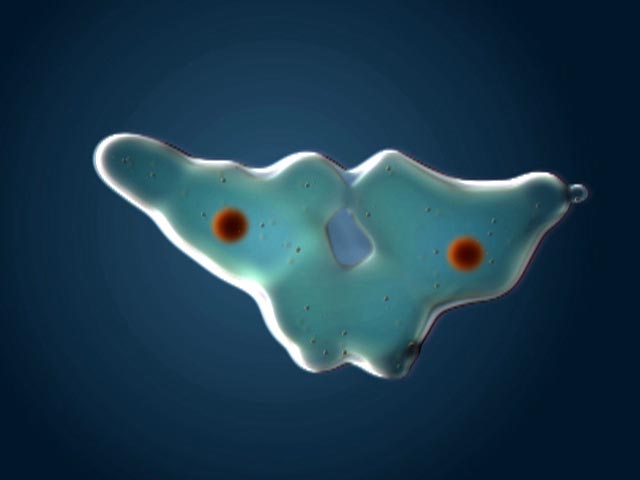 Living
systems reproduce. In many ways, reproduction seems like the most purposeful
thing that living systems do. Indeed, most nature shows describe this attribute
as a "desire", "goal" or "urge", often described
in these same shows as a process performed "in order to perpetuate the
species". Well, it is currently impossible for us to ascertain the "desires",
"goals" or "urges" of an ameoba or an oak tree; or whether
the amoeba or oak tree is 'thinking' about the survival of its species as it
reproduces. Thankfully, Darwin's theory of natural selection absolves us from
having to understand "desires" - it explains the existence of complex
physiology, morphology, and behavior as a function of the relative benefit of
that trait to relative reproductive success.
Living
systems reproduce. In many ways, reproduction seems like the most purposeful
thing that living systems do. Indeed, most nature shows describe this attribute
as a "desire", "goal" or "urge", often described
in these same shows as a process performed "in order to perpetuate the
species". Well, it is currently impossible for us to ascertain the "desires",
"goals" or "urges" of an ameoba or an oak tree; or whether
the amoeba or oak tree is 'thinking' about the survival of its species as it
reproduces. Thankfully, Darwin's theory of natural selection absolves us from
having to understand "desires" - it explains the existence of complex
physiology, morphology, and behavior as a function of the relative benefit of
that trait to relative reproductive success.
In this context, the adaptive value
of reproduction is as obvious as the the difference between "1" and
"0". Think about it this way: the natural world is a dangerous place.
It is exciting and fun for a while, but all living things will eventually die
as a consequence of encountering an environment in which they cannot survive
(flood, fire, heat, or cold), or being eaten by a predator, or infected by a
pathogen, or simply by accident. So, the only life forms that will persist through
time are those that copy themselves at a faster rate than they are dieing. This
works from the cell level through the populational level, and even at the phylogenetic
level with respect to the persistence of particular lineages through geologic
time. So, for any population, if the birth rate remains lower than the death
rate then population will eventually go extinct. In a multicellular organism,
if the rate of cell production is lower that the rate of cell death, the organism
will waste away, losing tissue mass. At a geologic scale, lineages that produce
species faster than the extinction rate will persist longer through time that
lineages where the rate of speciation is lower than the rate of extinction.
So today, when we look at the entire diversity of the living world, we only
see descendants of those life forms that reproduced. And these living life forms
have inherited this capacity to reproduce, as well.
In terms of natural selection, members
of a population that do not reproduce at all have a differential reproductive
success of "0". Selection will favor organisms that evolve the capacity
to reproduce. For prokaryotes, cell reproduction occurs by binary fission. For
eukaryotic cells, cell reproduction occurs by mitosis. In single-celled protists,
mitosis produces two new organisms. In multicellular organisms, mitosis produces
new cells that can replace dead cells or increase the number of cells in the
organism. If the net number of cells increases, the multicellular organism grows.
As we have mentioned before, growth is usually a good thing. First, the bigger
you are, the fewer things can eat you. Second, becoming larger through multicellularity
allows for the increased efficiency and functional diversity of cell specialization.
2. An overview
of cell division:
Cell division is the process of producing
two functional 'daughter' cells from one ancestral 'parental' cell. In order
for both of the daughter cells to have the full functional repertoire of the
original parental cell, they must be able to make the full complement of proteins
that the parent cell makes. In order for this to happen, they must both receive
the full complement of genetic information (DNA) in the parental cell. Hmmm....
how can they BOTH get the FULL COMPLEMENT of genetic information in the parental
cell? Well, in order for this to happen, the parental cell must duplicate its
DNA prior to cell division. This process of DNA replication produces two full
complements of genetic information. Then, this genetic information must be divided
evenly, in an organized manner, to insure that both daughter cells get the complete
complement of information (and not a duplication of some information or an omission
of other information). Cells that receive an incomplete complement of genetic
information will not be able to make all the proteins the parental cell made,
and may not be able to survive. So, again, DNA replication and the process of
mitosis are of great selective, adaptive value. Only cells that replicate and
divide their genetic information evenly, with only minor errors or inconsistencies,
will be likely to survive. These survivors will pass on the tendancy to replicate
and divide their genetic information evenly, as well. So, there is very strong
selection ( a very large selective advantage) for correct DNA replication and
equal chromosomal allocation during mitosis.
These processes of DNA replication
and mitosis are only two stages in the life of a cell. To place them in context,
it's useful to consider the full life of a cell, from it's production by the
division of its parental cell through to its own division.
 A.
The Cell Cycle
A.
The Cell Cycle
1. Interphase
- the 'interval' between divisions
a. G1
Our cell's life begins. That's sort
of a funny way to put it, because it seems to suggest that it is something new;
yet all of its constituents were part of the original parental cell. It is more
truly "1/2 an old cell with a full complement of DNA". Nevertheless,
it is an independent entity. In most protists, binary fission of the mitochondria
and chloroplasts occurs concurrently with the division of the nucleus during
mitosis, so the daughter cells have 'new' organelles, too. But in most multicellular
organisms, the allocation of organelles is largely a random process based on
how they are distributed in the cytoplasm during division. Then, the organelles
divide and 'repopulate' each daughter cell in G1.
The cell is roughly 1/2 the size
of the original parental cell. To grow to its appropriate size, it must synthesize
new biological molecules - and that means making the enzymes that will catalyze
those reactions. So, the DNA unwinds to the 'beads on a string' level, and the
genes between histones are available for transcription. When the DNA is unwound
('diffuse'), separate chromosomes cannot be seen with a light microscope. Rather,
the nucleus stains a uniform color except for one or several dark regions called
'nucleoli' (singular = nucleolus). These are areas were large amounts of r-RNA
are being synthesized and complexed with ribosomal proteins into functional
ribosomes. The ribosomes are exported from the nucleus to the cytoplasm, where
they will anchor to endoplasmic reticulum or the cytoskeleton.
Indeed, the G1 phase of a cell's
life is the most metabolically active period of it's life. It is growing in
size, and producing the proteins appropriate for its tissue type. Most cells
in multicellular organisms specialize during this period. Cells with very specific
structural adaptations to their specialized tissue type - like neurons with
long axons and muscle cells crammed with linear microfilaments - often remain
stalled in this stage after they become specialized; they do not divide again.
In this case, this stalled 'permanent' G1 phase is referred to a G0 ("G-nought').
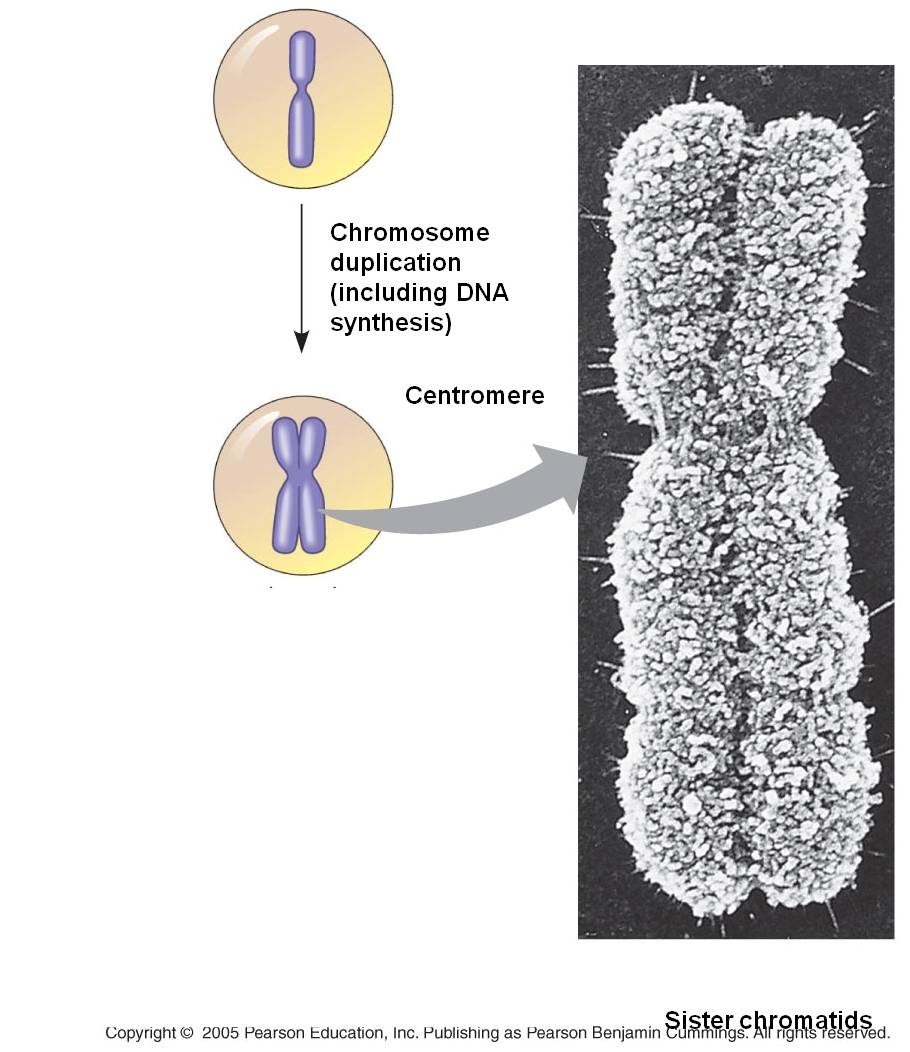 b.
S
b.
S
The S phase of the cell cycle is
when DNA replication occurs. The chromosomes are diffuse during this stage,
as well, so the enzymes (DNA polymerases) that replicate the DNA can access
the helices. Each double helix is separated, and the single strands are used
as templates for the formation of new helices on each template - changing one
double helix into two. Terminology becomes a bit ambiguous here. A DNA double
helix is equivalent to a "chromatid". A chromosome may have one chromatid
(in its unreplicated form) or two chromatids (in its replicated form). DNA replication
is a rather complicated process described in more detail below. The transition
from the G1 to the S phase is a very critical stage in a cell's life cycle,
signalling the cell's progression towards division. In eukaryotes it is called
a 'restriction point'. Once the S phase begins, the cell will proceed through
to mitosis. This transition is orchestrated by a complex interplay of transcription
factors that regulate the activity of "cell division cycle genes".
These genes produce cyclin proteins that vary in concentration through the cell
cycle. They bind with 'cyclin-dependent kinases' and these cdk-cyclin complexes
activate transcription factors that initiate the next phase of the cell cycle.
The timing of the G1/S transition
is very important. During the G1 phase, the DNA is 'checked' by repair enzymes...
mismatched bases and other mutations are corrected. It is important that the
G1 lasts long enough for DNA repair to take place; otherwise any errors will
be copied during DNA replication and mutations will be passed to the next generation
of cells. There are several proteins that inhibit the progression of the cell
cycle - the most notable is called p53. This protein is a cell cycle inhibitor,
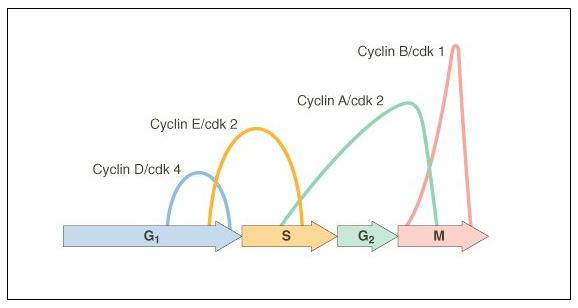 indirectly causing
the inactivation of cdk-cyclin complexes that would stimulate the onset of the
S phase. Mutations in this gene can make the protein non-functional; so cdk-cyclins
are not inhibited, and the onset of S happens quickly and prematurely - before
DNA repair is completed. This mutation is passed to the daughter cells, too,
along with all the other uncorrected mutations. These mutations accumulate with
each generation of cell division, affecting other genes that influence cell
function and specialization. This unregulated division of undifferentiated cells
creates a cancerous tumour. There are several other 'tumor suppressor' genes,
but mutations in p53 occur in 70% of small cell lung cancers, 80% of non-melanoma
skin cancers, and 60% of colon cancers. Obviously, correct regulation of the
cell cycle is critical to correct cell function and maintaining the integrity
of DNA.
indirectly causing
the inactivation of cdk-cyclin complexes that would stimulate the onset of the
S phase. Mutations in this gene can make the protein non-functional; so cdk-cyclins
are not inhibited, and the onset of S happens quickly and prematurely - before
DNA repair is completed. This mutation is passed to the daughter cells, too,
along with all the other uncorrected mutations. These mutations accumulate with
each generation of cell division, affecting other genes that influence cell
function and specialization. This unregulated division of undifferentiated cells
creates a cancerous tumour. There are several other 'tumor suppressor' genes,
but mutations in p53 occur in 70% of small cell lung cancers, 80% of non-melanoma
skin cancers, and 60% of colon cancers. Obviously, correct regulation of the
cell cycle is critical to correct cell function and maintaining the integrity
of DNA.
c. G2
After DNA replication is complete
the cell goes through another rapid period of growth in preparation for mitosis.
The DNA is checked again for damage caused and errors made during DNA replication.
Once again, p53 inhibits the transition to the mitotic phase, providing time
for this repair to take place. In cancer cells with mutations in p53, the G2
phase may be nearly eliminated, with the cell proceeding directly from DNA replication
to mitosis. CDK's bind to new cyclins, and these complexes active a different
set of proteins that initiate mitosis.
2. Mitosis
The process of mitosis can be summarized
as follows: the chromosomes condense, making it easier to divy them up evenly.
The replicated chromsomes are aligned in the middle of the cell by cytoskeletal
fibers. Each chromosome consistes of two identical double helices, called chromatids.
During the process of mitosis, these chromatids separate from each other, and
one double-helix from each chromosome is pulled to each end of the cell. The
membrane and cytoplasm are divided and the nuclear membrane reforms around the
chromosomes in each daughter cell. We will look at this process in more detail,
below.
B. DNA Replication
102 ALERT!! The
presentation that follows is a bit too detailed... I want you to know:
- That one DNA double helix "splits", and each strand
is used as a template... with a new strand being added to each to make 2
double-helices.
- An RNO polymerase is invovled to start the process,
so pieces of RNA are in the new DNA (initially)
- The RNA has to be cut out, and DNA is made that
fills the gaps... making a complete new strand of DNA
Both new double helices are IDENTICAL to each other
1. Initiation
An assemblage of enzymes, collectively
called a 'replisome', bind to the DNA molecule at sequences called 'replication
origins'. Eukaryotes have large genomes, and there are hundreds or thousands
of replication origins across the chromosomes in a eukaryotic genome.
Within the replisome, the enzyme
helicase separates the helices, unzipping the DNA.
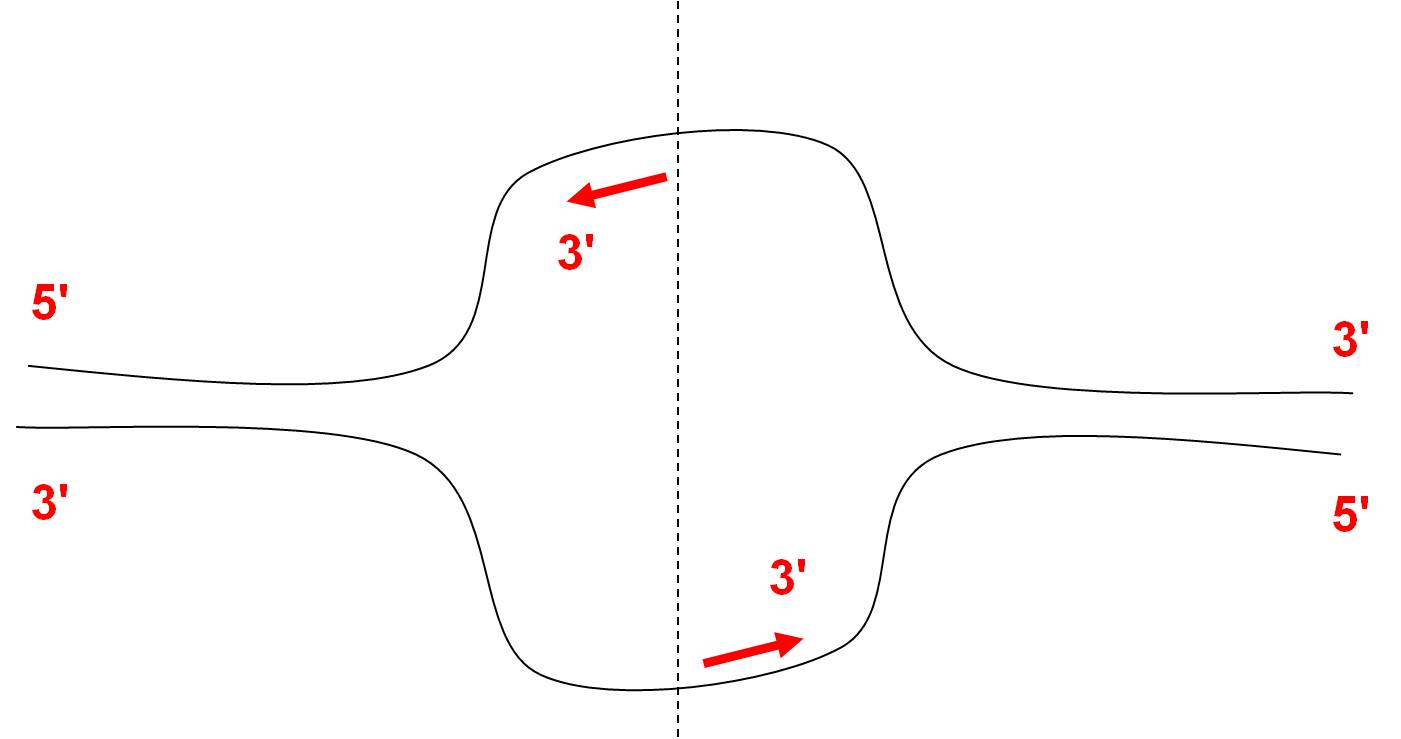 DNA
replication begins in an unusual way. RNA polymerases, called RNA primases,
create a short strand of RNA on each of the DNA templates, in a 5'-->3' direction.
This occurs because DNA polymerases cannot initiate the process - they can only
add bases to the 3' end of an existing nucleic acid. However, this may also
be a "vestigial" structure of the ancestral RNA world - when RNA polymerases
predated DNA polymerases and may have been used to produce the RNA genomes from
the newly formed DNA template (formed from reverse transcriptase). The short
piece of RNA is know as RNA primer; it provides a free 3'-OH group for the DNA
polymerase to add DNA nucleotides. DNA Polymerases displace the primases and
add DNA to both strands in a 5'--> 3' direction.
DNA
replication begins in an unusual way. RNA polymerases, called RNA primases,
create a short strand of RNA on each of the DNA templates, in a 5'-->3' direction.
This occurs because DNA polymerases cannot initiate the process - they can only
add bases to the 3' end of an existing nucleic acid. However, this may also
be a "vestigial" structure of the ancestral RNA world - when RNA polymerases
predated DNA polymerases and may have been used to produce the RNA genomes from
the newly formed DNA template (formed from reverse transcriptase). The short
piece of RNA is know as RNA primer; it provides a free 3'-OH group for the DNA
polymerase to add DNA nucleotides. DNA Polymerases displace the primases and
add DNA to both strands in a 5'--> 3' direction.
2. Replication
"at the fork"
Of course, the anti-parallel nature
of the DNA double helix creates a problem. As DNA is unwound (creating a 'fork'
of single stranded DNA template) one template (the 'leading strand') is oriented
3'-->5' into the fork. No problem. As this DNA is unwound, DNA polymerase
can extend the newly synthesized DNA in a complementary 5'-->3' direction.
However, there is a problem on the other 'lagging' strand. The single stranded
DNA template is revealed in a 5'-->3' direction on this strand, so polymerization
of the new strand cannot be continuous into the fork (because synthesis of the
new strand must be in a 5'-->3' direction, away from the fork). To replicate
this strand, primase must create another short stretch of RNA primer, and DNA
polymerase must elongate the strand 5'-->3' away from the fork.
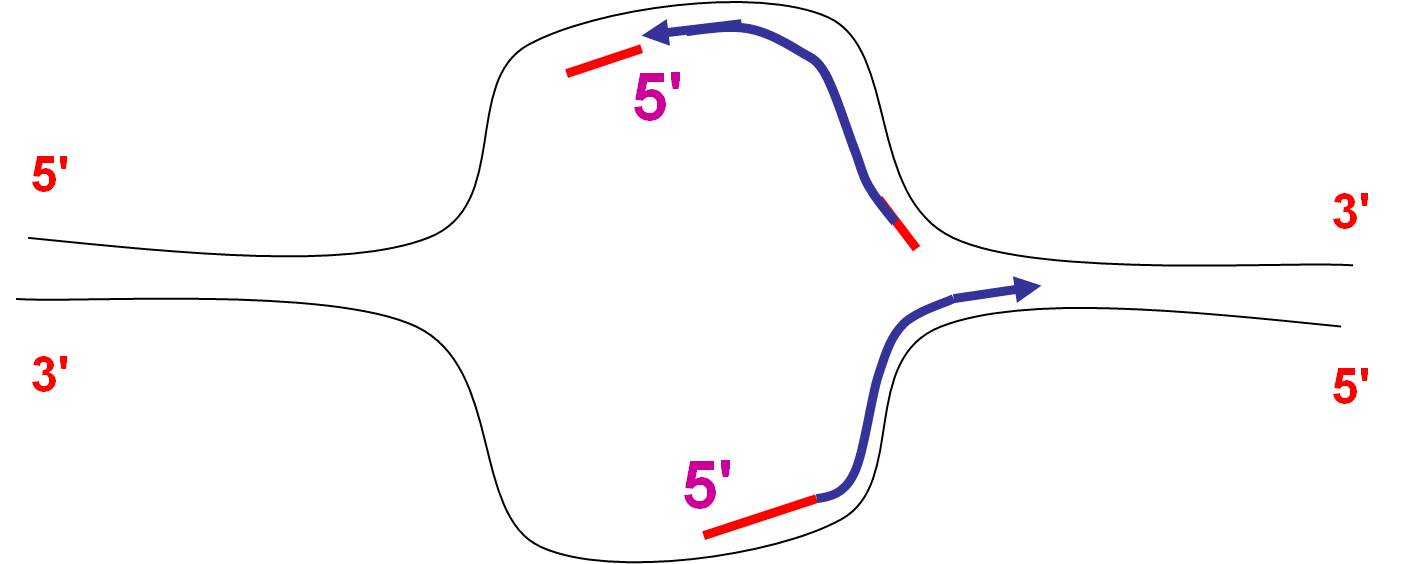 Again,
as the helicase continues to unwind the DNA, the leading strand can be replicated
continuously, just by adding new bases that are complementary to the template.
On the lagging strand, RNA primase must lay down another primer, and DNA polymerase
must 'backfill' the gap, filling in the space "behind" the last RNA
primer sequence. This is accomplished by the DNA forming a loop on the lagging
strand, so it can be pulled through the replisome in the same direction as the
leading strand. DNA polymerase fills in this space with DNA, but it does not
link the DNA to the 5' end of the neighboring RNA primer. So, on this
strand at this fork, DNA synthesis is discontinuous. Short fragments
of DNA are created, beginning with a short primer of RNA. These fragments are
called Okazaki fragments, after the scientist who identified them.
Again,
as the helicase continues to unwind the DNA, the leading strand can be replicated
continuously, just by adding new bases that are complementary to the template.
On the lagging strand, RNA primase must lay down another primer, and DNA polymerase
must 'backfill' the gap, filling in the space "behind" the last RNA
primer sequence. This is accomplished by the DNA forming a loop on the lagging
strand, so it can be pulled through the replisome in the same direction as the
leading strand. DNA polymerase fills in this space with DNA, but it does not
link the DNA to the 5' end of the neighboring RNA primer. So, on this
strand at this fork, DNA synthesis is discontinuous. Short fragments
of DNA are created, beginning with a short primer of RNA. These fragments are
called Okazaki fragments, after the scientist who identified them.
Because of the antiparallel nature
of the double helix, the laggin strand at one fork is the leading strand at
the other fork (see ppt. Also, on the picture to the right, think about how
the botttom helix will be replicated to the left. The complementary strand can't
be extended from the 5' end of the RNA primer. Instead, RNA primase must create
anothe strand far to the left, and DNA synthesis must prceed left to right,
5'-->3', on this bottom strand. As more DNA is unwound to the left, this
process must be repeated; creating Okazaki fragments on the bottom strand).
So, there are fragments on both strands.
These videos provide good representations
of this process, in a realistic (video 1), and more schematic (video 2) view.
The discontinuous nature of replication on the laggin strand is easiest to understand
in the ppt, and you will need to be able to draw this process in this way. The
only thing that is not included is the looping, 3-d conformation that the lagging
strand takes.
video 1
video 2
3. DNA Repair
Repair enzymes interact with the
DNA, reacting with DNA that is too wide or narrow because of mismatched base
pairs. In addition, repair enzymes cut out the RNA primers. Other DNA polymerases
fill the gaps with DNA. Ligase forms the last phosphodiester bond, linking the
fragments together.Eventually, the process of synthesis emanating from neighboring
origins connect - and the entire chromosome is replicated.
This process separates two original
helices, and builds new DNA on each old template. So, each new double helix
contains one old helix from the original strand, and one newly synthesized strand.
As such, this process is called "semi-conservative", because each
new double helix conserves half of the original double helix. These two double
helices, which are identical to one another, are connected at the centromere.
Proteins aggregate at these sequences during mitosis, forming a structure called
the kinetochore. The kinetochore anchors the chromosome to the fibers in the
spindle apparatus during mitosis.
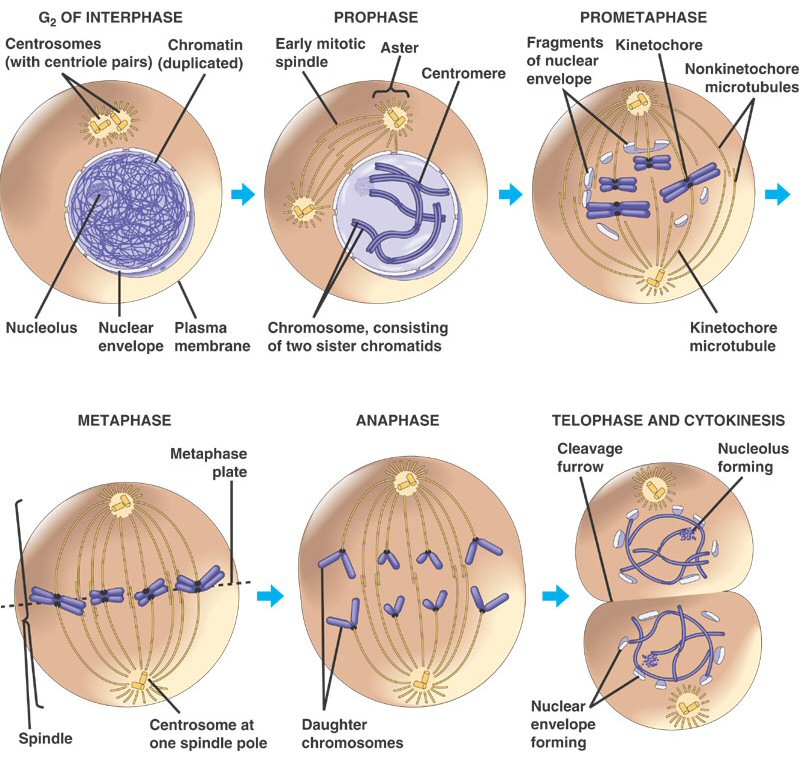 C.
Mitosis
C.
Mitosis
Mitosis is a continuous process of
chromosome condensation, chromatid separation, and cytoplasmic division. This
process is punctuated by particular events that are used to demarcate specific
stages. This process was first described by Walther Flemming in 1878, we he
developed new dyes and saw 'colored bodies' (chromo-somes) condensing and changing
position in dividing cells. He also coined the term 'mitosis' - the greek word
for thread - in honor of these thread-like structures.
1. Prophase:
The transition from G2 to Prophase of Mitosis is marked by the condensation
of chromosomes.
2. Prometaphase:
The chromosomes continue to condense, and the nuclear membrane disassembles.
The microfibers of the spindle apparatus attach to the kinetochores on the replicated
chromsomes.
3. Metaphase:
The spindle aranges the chromosomes in the middle of the cell.
4. Anaphase:
The proteins gluing sister chromatids together are metabolized, and the sister
chromatids are pulled by their spindle fibers to opposite poles of the cell.
It is important to appreciate that these separated chromatids (now individual,
unreplicated chromosomes) are idnetical to one another and identical to the
orignial parental chromosome (aside from unrepaired mutations).
5. Telophase:
The cell continues to elongate, with a concentrated set of chromosomes at each
end. Nuclear membranes reform around each set of chromosomes, and the chromosomes
begin to decondense.
6. Cytokinesis:
Cytokinesis is sometimes
considered a part of telophase. In this stage, the cytoplasm divides. In animal
cells, the membrane constricts along the cell's equator, causing a depression
or cleavage around the mid-line of the cell. This cleavage deepens until the
cells are pinched apart. In plants, vesicles from the golgi coalesce in the
middle of the cell, expanding to form a partition that divides the cell and
acts as a template for the deposition of lignin and cellulose that will form
the new cell wall between the cells.
As a consequence of this process,
two cells are produced from one parental cell, each having a complete complement
of genetic information - a copy of each original chromosome that was present
in the parental cell. Each of these cells now begins the G1 phase of interphase.
A Darwinian View of Life
I. Overview: The
Evolution of Biology
Overview
The idea of observing a natural phenomenon,
proposing a testable hypothesis of causality to explain that phenomenon, and
then testing that hypothesis to determine its validity has NOT been a formal
method of inquiry throughout human history. Although processes of "trial
and error" in solving mechanical problems almost necessitate at least an
unconscious 'scientific' process, explanations of how the world IS,
or why it is THIS WAY, were promoted by philosophers long before the
tool of science developed. A very brief overview of the birth of science, as
it relates to the study and explanation of life, is therefore important and
instructive for understanding why Darwin's ideas were both revolutionary and
yet - in some sense - historically anticipated.
A. The Greeks
1. Hippocrates
(450-377 bc): He valued observation and testing rather than pure logic
- "cut-it-open-and-see" - Believed in use and disuse and inheritance of acquired
traits; so accepted change within a "family". - Close to an embryological, evolutionary
approach, and physicians today honor his philosophy of "first, do no harm"
in the Hippocratic Oath.
 2.
Plato (427-347 bc):
Plato was trained in the Pythagorean school, and was more truly a pure philosopher
rather than a 'naturalist', per se. As such, he was more impressed by generalizations
rather than the vagarities and variation of individual experience; indeed, those
variations that are so important to a true understanding of biology.
2.
Plato (427-347 bc):
Plato was trained in the Pythagorean school, and was more truly a pure philosopher
rather than a 'naturalist', per se. As such, he was more impressed by generalizations
rather than the vagarities and variation of individual experience; indeed, those
variations that are so important to a true understanding of biology.
UNIVERSAL PHILOSOPHY (four dogmas)
- Essentialism: (essences perfect;
material world is an imperfect reflection of these perfect essences/'ideals'
(eidos). Cave
analogy; triangle example.
- Universal Harmony: essences form
a perfect whole - can’t change
- Demi-Urge: creative force that
made the essences
- Soul: non-corporeal "spark of
life" in living systems; maximized in humans.
- became the bedrock of western
civilization for 2000 years! Ernst Mayr, one of the most important biologists
of the 20th century, states: "It took more than 2000 years for biology, under
the influence of Darwin, to escape the paralyzing grip of essentialism...the
rise of modern biology is, in part, the emancipation from Platonic thinking".
 3.
Aristotle
(384-322 bc): Aristotle was
the first great philosopher interested in biology. He described 100’s of species
and fossils, and he wrote books on anatomy, reproductive biology, and life histories.
He was Plato's student and Alexander the Great's tutor. He was more of an empiricist
than Plato, using observation (and not reason, alone), to answer some questions
about the natural world. Indeed, he is credited with describing the first formal
rules of deductive and inductive logic. He believed that knowledge could be
discovered from observations (induction), but he did not include an experimental
component to his methodology - rather, the evaluation of alternative, "induced"
hypotheses was by logical decuctive reasoning, alone. He affirmed the Platonic
ideals of a harmonious, static whole, with fixed species created by an "unmoved
mover" in an array from simple to complex in a great chain of being (Scala
naturae) of increasing perfection.
3.
Aristotle
(384-322 bc): Aristotle was
the first great philosopher interested in biology. He described 100’s of species
and fossils, and he wrote books on anatomy, reproductive biology, and life histories.
He was Plato's student and Alexander the Great's tutor. He was more of an empiricist
than Plato, using observation (and not reason, alone), to answer some questions
about the natural world. Indeed, he is credited with describing the first formal
rules of deductive and inductive logic. He believed that knowledge could be
discovered from observations (induction), but he did not include an experimental
component to his methodology - rather, the evaluation of alternative, "induced"
hypotheses was by logical decuctive reasoning, alone. He affirmed the Platonic
ideals of a harmonious, static whole, with fixed species created by an "unmoved
mover" in an array from simple to complex in a great chain of being (Scala
naturae) of increasing perfection.
4. Summary:
There is a rather schizoid biological inheritance from the greeks. On one hand,
Aristotle and Galen provide much correct (an erroneous) factual knowledge about
the natural world, and Aristotle's contributions in logic are the foundations
of the scientific method. However, the Platonic essentialism that dominated
a philosophy of nature would inhibit consideration of evolutionary ideas, and
the emphasis on reason as the ultimate arbiter of truth hindered an experimental
approach.
B.
The Persians (latinized name used in the west)
1. Ibn
al-Haytham (Alhazen) (965-1040):
Born in Basra (now in Iraq), he is credited with presenting the first formal
process of observation, hypothesis, experimental test using quantification and
math, and conclusion. In his major work,Book on Optics (1021), he describes
his experiments that falsified the notion that sight is caused by particles
that radiate from the eye (as argued by Ptolemy) or radiate from the object
(as argued by Aristotle).
2. al-Biruni
(973-1048): Born in what is
now Uzbekistan, al-Biruni applied a scientific method to new fields, basically
inventing the disciplines of comparative sociology (in the study and comparison
of cultures) and experimental psychology. His contributions to astronomy are
even more profound, as he considered the hypothesis that the earth travels in
an ellipse around the sun and spins on its axis daily, and he measured the radius
of the Earth 600 years before a correct estimate would be made in the west.
His most valuable contributions to the progress of science were his emphatic
reliance on precise quantification and repeated observations. He believed that
error caused by instrimentation or human error could be compensated for by taking
the average of repeated observations.
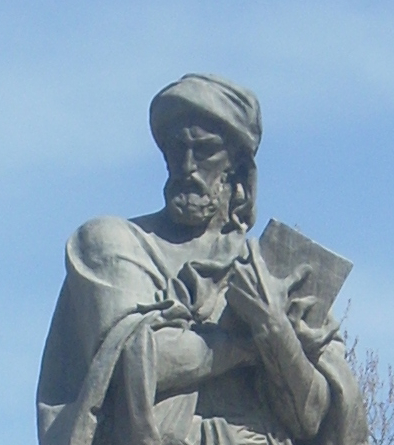 3.
Ibn Sena (Avicenna) (980-1037):
Also born in what is now Uzbekistan, Avicenna was a contemporary of al-Biruni
and is considered one of the greatest philosophers in history. Although he was
closer to Aristotle than al-Biruni, he still felt that Aristotle's philosophy
of induction needed the critical element of experimentation to test the conclusions.
Avicenna is primarily known for building on the works of Hippocrates, Galen,
and Aristotle, making contributions to medicine that were used throughout Europe
in the Middle Ages.
3.
Ibn Sena (Avicenna) (980-1037):
Also born in what is now Uzbekistan, Avicenna was a contemporary of al-Biruni
and is considered one of the greatest philosophers in history. Although he was
closer to Aristotle than al-Biruni, he still felt that Aristotle's philosophy
of induction needed the critical element of experimentation to test the conclusions.
Avicenna is primarily known for building on the works of Hippocrates, Galen,
and Aristotle, making contributions to medicine that were used throughout Europe
in the Middle Ages.
4. Summary:
The Persians were the first to explicitly describe and study natural phenomena
in the language of mathematics. Building on aristotelian ideas of induction
and hypothesis formation, the Persians added the critical concept of empirical,
quantitative, replicated experimentation to test hypotheses. This is the scientific
method.
C. The Middle Ages
(476-1400)
 1.
Constantine the Great
(reign 306-337 - First Holy Roman Emperor) - His conversion to Christianity
signalled a change in the west from the polytheism of ancient Greece and Rome
to monotheism; and the tenets of a single, perfect, static creation meshed well
with the dominant Platonic philosophy of essentialism.
1.
Constantine the Great
(reign 306-337 - First Holy Roman Emperor) - His conversion to Christianity
signalled a change in the west from the polytheism of ancient Greece and Rome
to monotheism; and the tenets of a single, perfect, static creation meshed well
with the dominant Platonic philosophy of essentialism.
2. Thomas
Aquinas (1225-1274) - Aquinas presented the most formal logical argument
for the existence of God, largely using the teleological argument of design.
Events or objects that move towards a goal (have a purpose) a primary cause;
Aristotle's "unmoved mover" is Thomas's Christian God. Thomas professed
a "natural theology", which suggested that one could come to know
more of God by studying "His works" (nature).
3. Summary:
The unification of political, religious, and economic power in the Roman-Catholic
Church created a monolithic cultural authority that was resistant to alternative
views. The Church claimed its inerrant authority from an inerrant Bible, so
facts or ideas in conflict with the Bible were at least wrong, and at most heretical;
alternative sources of truth and authority (like scientific investigations)
were implicit challenges to the power of the church. During this period, however,
several western philosopher-theologians like Aquinas and Robert
Grosseteste (~1168-1253; translator of Aristotle) and Roger
Bacon (1220-1292) read translations of muslim philosophers and exposed the
west to the power of Aristotelian logic and experimentation.
D. The Renaissance
(1400 to 1700)
1. Cultural
Climate: The political and cultural tumult of the Protestant Reformation,
the formation of the Church of England, and the development of a merchant class
and trade, undermined the hegemony of the Roman-Catholic Church and placed a
greater premium on knowledge of mechanics and the physical world. At the same
time, the voyages of discovery of Dias (1488) - who rounds the Cape without
burning up - and Columbus 1492) revealed new species and lands not described
in the Bible. The Roman Inquisitions begun in the 16th century were attempts
to maintain control over heretics and their ideas. On February 16, 1600, Italian
philospher Giordano Bruno was burned at the stake for heresy - probably due
to his persistent promotion of logic, reason, and empiricism as a source of
truth, rather than religious authority. His support for the copernican system
may also have played a role. Protestants were equally adamant in their beliefs,
and John Calvin had Michael Servetus burned at the stake for heresy in 1553.
 2.
1543: The publication of two
works had a profound impact. Nicolaus
Copernicus's De
revolutionibus orbium coelestium (On the Revolutions of the Heavenly
Spheres) described the heliocentric model of the solar system, opposing the
terracentric view supported by both the authority of the ancients (Ptolemy
and Aristotle) and the Bible. Interestingly, Copernicus still depended on philosophical
preferences over observation - he imagined that the planets travelled in circles,
not ellipses, because the circle was a more perfect form. Likewise, Andreas
Vesalius's De
humani corporis fabrica (On the Fabric of the Human body) was published
in 1543. Profitting from the renaissance developments in art and printing, Vesalius
was able to include exquisite drawings of dissected cadavers. Through this empirical
approach to human anatomy, many errors of the ancients (Galen,
in particular) were revealed. In short, as Francis
Bacon (1561-1626) concluded, knowledge is incomplete; it is not all found
in the Bible or the ancient texts, and new knowledge is discovereable by the
process of empirical hypothesis testing.
2.
1543: The publication of two
works had a profound impact. Nicolaus
Copernicus's De
revolutionibus orbium coelestium (On the Revolutions of the Heavenly
Spheres) described the heliocentric model of the solar system, opposing the
terracentric view supported by both the authority of the ancients (Ptolemy
and Aristotle) and the Bible. Interestingly, Copernicus still depended on philosophical
preferences over observation - he imagined that the planets travelled in circles,
not ellipses, because the circle was a more perfect form. Likewise, Andreas
Vesalius's De
humani corporis fabrica (On the Fabric of the Human body) was published
in 1543. Profitting from the renaissance developments in art and printing, Vesalius
was able to include exquisite drawings of dissected cadavers. Through this empirical
approach to human anatomy, many errors of the ancients (Galen,
in particular) were revealed. In short, as Francis
Bacon (1561-1626) concluded, knowledge is incomplete; it is not all found
in the Bible or the ancient texts, and new knowledge is discovereable by the
process of empirical hypothesis testing.
 3.
Kepler (1571-1630) and
Galileo (1564-1642)
were the first great natural philosophers in the west to emphasize and use a
mathematical, experimental approach to answer questions about the physical world.
Galileo's observations of the moons orbiting Jupiter, and the full phases
of Venus (impossible to explain with a Ptolemaic model of the solar system),
provide empirical support for the copernican
model. Galileo, however, was still wedded to the philosophical imperative
that the orbits were perfect circles. Kepler attacked this view with voluminous
data collected by he and his mentor, Tycho
Brahe. By using elliptical orbits, Kepler was able to fashion the most precise
predictive models of planetary orbits available. Galileo was a devout Catholic,
but he famously said that the Bible tells a person "how to go to heaven,
not how the heavens go". In this, and in his goad to "Measure what
is measurable, and make measurable what is not so", he personifies the
quantitative scientist. In his Dialogue
Concerning the Two Chief World Systems (1632), he publicized the debate
over these worldviews. The Roman-Catholic church brought him to trial
for heresy, and he was ultimately forced to recant
his support for the Copernican model before the Commissary-General of the Inquisition
in Rome during 1633. He was ultimately placed under house arrest (confined to
his home
in Arcetri) for the remainder of his life.
3.
Kepler (1571-1630) and
Galileo (1564-1642)
were the first great natural philosophers in the west to emphasize and use a
mathematical, experimental approach to answer questions about the physical world.
Galileo's observations of the moons orbiting Jupiter, and the full phases
of Venus (impossible to explain with a Ptolemaic model of the solar system),
provide empirical support for the copernican
model. Galileo, however, was still wedded to the philosophical imperative
that the orbits were perfect circles. Kepler attacked this view with voluminous
data collected by he and his mentor, Tycho
Brahe. By using elliptical orbits, Kepler was able to fashion the most precise
predictive models of planetary orbits available. Galileo was a devout Catholic,
but he famously said that the Bible tells a person "how to go to heaven,
not how the heavens go". In this, and in his goad to "Measure what
is measurable, and make measurable what is not so", he personifies the
quantitative scientist. In his Dialogue
Concerning the Two Chief World Systems (1632), he publicized the debate
over these worldviews. The Roman-Catholic church brought him to trial
for heresy, and he was ultimately forced to recant
his support for the Copernican model before the Commissary-General of the Inquisition
in Rome during 1633. He was ultimately placed under house arrest (confined to
his home
in Arcetri) for the remainder of his life.
 4.
Newton (1642-1727):
In Newton's Philosophiae
Naturalis Principia Mathematica (1687) we see the fulfillment of the
scientific method - the formation of testable general theory. Newton constructed
a general theoretical model of gravity and motion that became classical mechanics.
This theory explained the motion of earthly objects (apples and projectiles
falling) and the elliptical path of heavenly bodies. We see the culmination
of Aristotle's imperative for both inductive and deductive reasoning - from
specific observations one constructs a general hypothesis (inductive reasoning).
Now, you use deduction to create a prediction that follows from that hypothesis
(IF... THEN...). And of course, you subject your prediction to an experimental
test in which falsification is possible. Although other natural philosophers
(the term "scientist" was not coined until the 1830's) had been held
in high regard by some nations, kings, or patrons, Newton was knighted
- signifying the complete cultural acceptance of this new way of examining the
physical world.
4.
Newton (1642-1727):
In Newton's Philosophiae
Naturalis Principia Mathematica (1687) we see the fulfillment of the
scientific method - the formation of testable general theory. Newton constructed
a general theoretical model of gravity and motion that became classical mechanics.
This theory explained the motion of earthly objects (apples and projectiles
falling) and the elliptical path of heavenly bodies. We see the culmination
of Aristotle's imperative for both inductive and deductive reasoning - from
specific observations one constructs a general hypothesis (inductive reasoning).
Now, you use deduction to create a prediction that follows from that hypothesis
(IF... THEN...). And of course, you subject your prediction to an experimental
test in which falsification is possible. Although other natural philosophers
(the term "scientist" was not coined until the 1830's) had been held
in high regard by some nations, kings, or patrons, Newton was knighted
- signifying the complete cultural acceptance of this new way of examining the
physical world.
5. Summary:
During this period we see the development and application of the scientific
method in the west. The "scientific revolution" had a curious effect
on the study of life. Science emancipated physics, astronomy, and chemistry
from theology by describing constant, natural, predictive laws and by describing
the unchanging nature of elements (alchemy disproven). This confirmed the Platonic
views of an unchanging universe created in perfection and left to run like a
'clockwork'. But what about our little corner of the universe? Was the Earth
also static from 'the beginning", and just how long ago was that, anyway?
Anglican Bishop James Ussher
(1581-1656) applied logical rigor to the History of the Earth as revealed in
the Bible and counted back the generations, determining that creation began
at noon, October 23, 4004 b.c. (For a great book about calendars, read Stephen
J. Gould's Questioning the Millenium). Thomas
Burnet (~1635-1715) wrote The Sacred Theory of the Earth (1680),
an account of earth's history as a literal account of Genesis 1. So, both concluded
that the Earth was young, and most natural philosophers also concluded that
the species were fixed since their creation.
E. The Enlightment
(1700’S)
1. Cultural
Climate: The 1700's were a tumultuous century in Europe, punctuated by
the industrial revolution, the American Revolution, and the French Revolution.
Ideologies were shaken to their foundations, and the promise offered by science
and reason and industrial power challenged ideas of socieconomic stasis and
authoritarian rule.
2. Natural Theology
- Following on the thinking of Aquinas, there was a resurgence of Natural Theology
to explicitly consider the theological import and relvance of the new observations
made by science. The fundamental assumption was that God made things for a purpose,
and that we might understand God's purpose if we more fully describe the creation
and its operation. The most explicit reconstruction of these ideas was by theologian
William Paley's
Natural Theology: or, Evidences of the Existence and Attributes of the Deity,
Collected from the Appearances of Nature (1802). Here he provides his teleological
argument for the existence of God, using the allegory of the "watchmaker".
 a.
Carl Linne
(1707-1778) - "Linneaus"
(he latinized his own name) was the "great cataloguer", and he published
the first edition of Systema Naturae in 1735. It wasn't until 1753,
however, in Species Plantarum (Plant Species), that he formalized his prcedure
for using two names to identify a species - the latin binomen (like Homo
sapiens). The first name is the GENUS, and the second is called the 'specific
epithet' that describes this species and distinguishes it from other similar
species placed in the same genus. Linnaeus also grouped these genera (plural
of 'genus') into orders, classes, and kingdoms based on additional morphological
similarities. In plants, he relied on similarities in the reproductive structures,
as many naturalists accepted that species are kinds that reproduce only with
themselves. In the 10th edition of Systema Naturae (1758), he applied
this system to all animals, too. The oldest scientific species names used today
date from these two works. By the way, the word 'species' is both the singular
and plural. There is no 'specie'. FYI. : )
a.
Carl Linne
(1707-1778) - "Linneaus"
(he latinized his own name) was the "great cataloguer", and he published
the first edition of Systema Naturae in 1735. It wasn't until 1753,
however, in Species Plantarum (Plant Species), that he formalized his prcedure
for using two names to identify a species - the latin binomen (like Homo
sapiens). The first name is the GENUS, and the second is called the 'specific
epithet' that describes this species and distinguishes it from other similar
species placed in the same genus. Linnaeus also grouped these genera (plural
of 'genus') into orders, classes, and kingdoms based on additional morphological
similarities. In plants, he relied on similarities in the reproductive structures,
as many naturalists accepted that species are kinds that reproduce only with
themselves. In the 10th edition of Systema Naturae (1758), he applied
this system to all animals, too. The oldest scientific species names used today
date from these two works. By the way, the word 'species' is both the singular
and plural. There is no 'specie'. FYI. : )
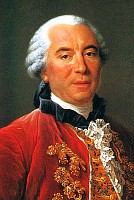 b.
Georges Louis Leclerc,
Comte de Buffon (1707-1788)
Buffon pulbished the first volume of his encyclopedic Histoire Naturelle
in 1749. Ernst Mayr considered Buffon to be the foremost biologist of the 18th
century, and Mayr wrote "it makes no difference which of the authors of the
second half of the 18th century one reads - their discussions are, in the last
analysis, merely commentaries on Buffon’s work. Except for Darwin and Aristotle,
there has been no other student of organisms who has had as far-reaching an
influence." He opposed the notion oif classification; if the species were separately
created, then of what use was any classification system? He was aware of possibility
of evolution but rejects it:
b.
Georges Louis Leclerc,
Comte de Buffon (1707-1788)
Buffon pulbished the first volume of his encyclopedic Histoire Naturelle
in 1749. Ernst Mayr considered Buffon to be the foremost biologist of the 18th
century, and Mayr wrote "it makes no difference which of the authors of the
second half of the 18th century one reads - their discussions are, in the last
analysis, merely commentaries on Buffon’s work. Except for Darwin and Aristotle,
there has been no other student of organisms who has had as far-reaching an
influence." He opposed the notion oif classification; if the species were separately
created, then of what use was any classification system? He was aware of possibility
of evolution but rejects it:
"Not only the ass and the horse, but also man, the apes, the quadrupeds,
and all the animals might be regarded as constituting but a single family...
If it were admitted that the ass is of the family of the horse, and different
from the horse only because it has varied from the original form, one could
equally well say that the ape is of the family of man, that he is a degenerate
man, that man and ape have a common origin; that, in fact, all the families,
among plants as well as animals, have come from a single stock, and that all
the animals are descended from a single animal, from which have sprung in the
course of time, as a result of progress or of degeneration, all the other races
of animals. For if it were once shown that we are justified in establishing
these families; if it were granted that among animals and plants there has been
(I do say several species) but even a single one, which has been produced in
the course of direct decent from another species; if, for example, it were true
that the ass is but a degeneration from the horse - then there would no longer
be any limit to the power of nature, and we should not be wrong in supposing
that, with sufficient time, she has been able from a single being to derive
all the other organized beings. But this is by no means a proper representation
of nature. We are assured by the authority of revelation that all animals have
participated equally in the grace of direct Creation and that the first pair
of every species issued forth fully formed from the hands of the Creator."
Histoire Naturelle
(1753)
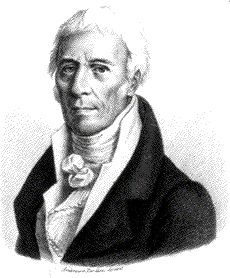 c.
Jean Baptiste Pierre Antoine de Monet, Chevalier de Lamarck
(1744-1829) - Initially
a botanist and tutor to Buffon's son, he became an expert in invertebrates and
the mollusc fossils of the Paris Basin. through this work, his initial belief
in the fixity of species changed. In his culminating work Philosophie
Zoologique (1809), he suggested that species change over time, climbing
the Scala Naturae from simple forms to complex. The simplest forms were continuously
produced by spontaneous generation, and species did not go extinct - they evolved
into more complex forms over long periods of time. In addition to this vertical
progression, they could also diverge as a consequence of responding to the environment
and passing on the traits they acquired as a result of the action of this environment.
Structures that were used in an environment would be elaborated (use and disuse),
and then these newly elaborated structures were passed on to offspring (inheritance
of acquired traits). Lamarck's evolutionary ideas explained the new observations
of fossil diversity and apparent extinction. In Lamarck's mind, extinctions
were theologically impossible, because he believed in a complete, harmonious
creation by a benevolent creator. Why would a benevolent, purposeful creator
let creations go extinct, and wouldn't the loss of some species render the perfection
of the initial creation imperfect? For Lamarck, species changing into other
species preserved the whole of creation. "May it not be possible that the fossils
in question belong to species still existing, but which have changed since that
time and have been converted into that similar species that we now actually
find?" Lamarck is rightly regarded as the first "biologist" (he was
the first to use the term) to propose a true evolutionary hypothesis, and a
testable, naturalistic mechanism to explain it. Unfortunately, the mechanism
was wrong.
c.
Jean Baptiste Pierre Antoine de Monet, Chevalier de Lamarck
(1744-1829) - Initially
a botanist and tutor to Buffon's son, he became an expert in invertebrates and
the mollusc fossils of the Paris Basin. through this work, his initial belief
in the fixity of species changed. In his culminating work Philosophie
Zoologique (1809), he suggested that species change over time, climbing
the Scala Naturae from simple forms to complex. The simplest forms were continuously
produced by spontaneous generation, and species did not go extinct - they evolved
into more complex forms over long periods of time. In addition to this vertical
progression, they could also diverge as a consequence of responding to the environment
and passing on the traits they acquired as a result of the action of this environment.
Structures that were used in an environment would be elaborated (use and disuse),
and then these newly elaborated structures were passed on to offspring (inheritance
of acquired traits). Lamarck's evolutionary ideas explained the new observations
of fossil diversity and apparent extinction. In Lamarck's mind, extinctions
were theologically impossible, because he believed in a complete, harmonious
creation by a benevolent creator. Why would a benevolent, purposeful creator
let creations go extinct, and wouldn't the loss of some species render the perfection
of the initial creation imperfect? For Lamarck, species changing into other
species preserved the whole of creation. "May it not be possible that the fossils
in question belong to species still existing, but which have changed since that
time and have been converted into that similar species that we now actually
find?" Lamarck is rightly regarded as the first "biologist" (he was
the first to use the term) to propose a true evolutionary hypothesis, and a
testable, naturalistic mechanism to explain it. Unfortunately, the mechanism
was wrong.
 d.
Georges Cuvier
(1769-1832) - Cuvier
was also an intellectual giant in France, and was Lamarck's nemesis. A great
anatomist, Cuvier founded the comparative approach in anatomy and also founded
vertebrate paleontology. Unlike Lamarck, he believed that extinctions occurred;
and he supported this contention by showing that the great mammals of the past
(mammoths, giant ground sloths, etc.) had no modern living forms (Cuvier concluded
that elephants and mammoths were different species, and mammoths were truly
extinct.) In contrast to Lamarck's ideas of gradually changing species responding
to their environment, Cuvier promoted the notion that there were period cataclysms
('revolutions') that killed off local faunas and required repopulation from
elsewhere. This idea became known as 'catastrophism', and stood in opposition
to the 'uniformitarianism' of gradual change espoused by Lamarck and others.
Cuvier also tore down the notion of the scala naturae, replacing it with four
'embranchments' of life disconnected from eachother. Finally, Cuvier said that
the intermediates predicted by Lamarck's gradualistic evolutionary model did
not exist, and he reminded the scientific community that spontaneous generation
had been refuted (for insects, at least) since the experiments of Francesco
Redi in 1668! He was a true essentialist, seeing discontinuity through time
and through taxa. Cuvier outlived Lamarck and continued to lambast him and his
ideas. Evolutionary ideas fell into disfavor as a consequence.
d.
Georges Cuvier
(1769-1832) - Cuvier
was also an intellectual giant in France, and was Lamarck's nemesis. A great
anatomist, Cuvier founded the comparative approach in anatomy and also founded
vertebrate paleontology. Unlike Lamarck, he believed that extinctions occurred;
and he supported this contention by showing that the great mammals of the past
(mammoths, giant ground sloths, etc.) had no modern living forms (Cuvier concluded
that elephants and mammoths were different species, and mammoths were truly
extinct.) In contrast to Lamarck's ideas of gradually changing species responding
to their environment, Cuvier promoted the notion that there were period cataclysms
('revolutions') that killed off local faunas and required repopulation from
elsewhere. This idea became known as 'catastrophism', and stood in opposition
to the 'uniformitarianism' of gradual change espoused by Lamarck and others.
Cuvier also tore down the notion of the scala naturae, replacing it with four
'embranchments' of life disconnected from eachother. Finally, Cuvier said that
the intermediates predicted by Lamarck's gradualistic evolutionary model did
not exist, and he reminded the scientific community that spontaneous generation
had been refuted (for insects, at least) since the experiments of Francesco
Redi in 1668! He was a true essentialist, seeing discontinuity through time
and through taxa. Cuvier outlived Lamarck and continued to lambast him and his
ideas. Evolutionary ideas fell into disfavor as a consequence.
II. Darwin's Contributions
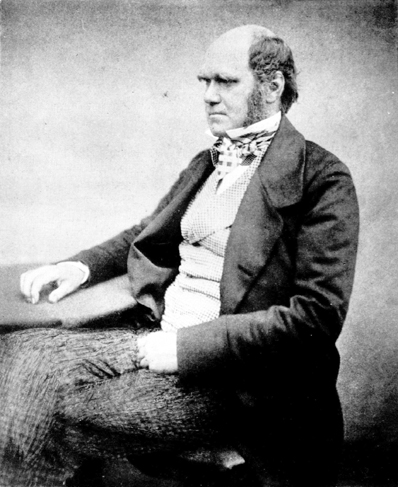 A.
Overview:
A.
Overview:
One of the great ironies of science
is that the two greatest contributions in biology - the theory of evolution
and the mechanistic principles of heredity - were described independently of
one another within a ten year period. It is ironic because genetics (heredity)
and evolution are so critically and intimately related...heredity describes
how genetic information is passed from parent to offspring. This creates relatedness
patterns within families, within species among populations, and among species.
These relationships are a focus of evolutionary studies. The publications marking
their official, orthodox ‘births’ were published only six years apart: Origin
of Species (1859), and Experiments
in Plant Hybridization (1865), yet it was nearly 80 years before these ideas
were placed in their proper context within the Modern Synthetic Theory of evolution.
In the first part of this course, we will examine these contributions in a historical
context. We will also briefly describe the cellular context in which the genetic
system operates.
1. Darwin's Life
- born Feb 12, 1809, into a wealthy
and distinguished family
- graduated Cambridge intending to join the clergy and study nature as a natural
theologian
- 1831-36: Naturalist aboard the H.M.S. Beagle
- 1859 - Publishes "The Origin of Species", which he revises through
six editions during his life
- dies April 19, 1882; interred in Westminster Abbey at the feet of Newton.
Darwin did three things in this book:
a. He summarized
the evidence for evolution (common descent) as an historical fact
b. He proposed mechanistic theories explaining ‘how’ evolution
might occur (Natural Selection, use and disuse)
c. He addressed the major problems with his ideas; notably
the ideas of apparent design (Paley), the discontinuity of the fossil record
(Cuvier), and the source of observed variation.
B. His Argument
- Evidence for Common Descent as Historical Fact
1.
Geology
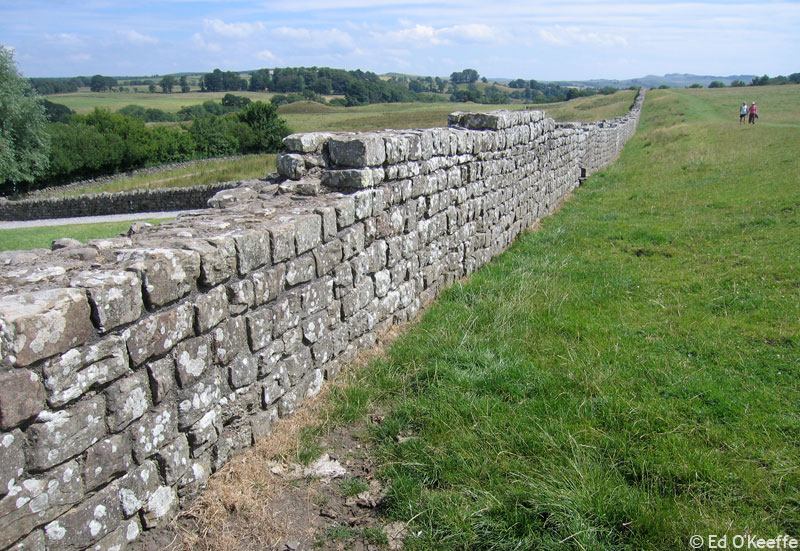 a.
James
Hutton (1726-1797): Hutton was the first great british geologist.
He compared Hadrian's wall - which looks new but was 1600 years old (122 AD)
- with natural rock outcrops that were strongly weathered. Hutton concluded
that the natural outcrops must be 100's of times older. He also examined an
important formation at Siccar Point, where one series of nearly vertical strata
is overlain by another series of horizontal strata. This is now called an 'unconformity',
and Hutton explained it as follows. Based on Steno's laws of superposition,
the bottom vertical sediments must have been laid down first, and they must
have been laid down horizontally. Ages must have passed between each deposit,
as each turned to rock. Then, uplifts must have occurred to bend them into a
vertical aspect. Long periods of erosion must take place to wear that uplift
flat, followed by the long intervals of time needed to deposit the second horizontal
series. Also, if erosion and deposition acted slowly (as current observations
show), then it must have taken a really long time to erode mountains or build
up marine deposits (White Cliffs of Dover). He concluded that this slow, 'uniformitarian'
cycle of deposition, uplift, erosion, and deposition meant that the Earth was
unfathomably old. Indeed, the cycle may mean that it's age might not be discoverable.
In short, Hutton concludes, the Earth has "no vestige of a beginning, no prospect
of an end."
a.
James
Hutton (1726-1797): Hutton was the first great british geologist.
He compared Hadrian's wall - which looks new but was 1600 years old (122 AD)
- with natural rock outcrops that were strongly weathered. Hutton concluded
that the natural outcrops must be 100's of times older. He also examined an
important formation at Siccar Point, where one series of nearly vertical strata
is overlain by another series of horizontal strata. This is now called an 'unconformity',
and Hutton explained it as follows. Based on Steno's laws of superposition,
the bottom vertical sediments must have been laid down first, and they must
have been laid down horizontally. Ages must have passed between each deposit,
as each turned to rock. Then, uplifts must have occurred to bend them into a
vertical aspect. Long periods of erosion must take place to wear that uplift
flat, followed by the long intervals of time needed to deposit the second horizontal
series. Also, if erosion and deposition acted slowly (as current observations
show), then it must have taken a really long time to erode mountains or build
up marine deposits (White Cliffs of Dover). He concluded that this slow, 'uniformitarian'
cycle of deposition, uplift, erosion, and deposition meant that the Earth was
unfathomably old. Indeed, the cycle may mean that it's age might not be discoverable.
In short, Hutton concludes, the Earth has "no vestige of a beginning, no prospect
of an end."
 b.
Charles Lyell (1797-1895):
Lyell promoted Hutton's ideas of a great age to the Earth and uniform rates
of change - making inferences based on the assumption of constant rates of physical
processes. Small changes, accumulating over a long time, could have big
effects. Lyell's three volume work Principles of Geology (1830-33)
opened Darwin's eyes as he read them on the H.M.S. Beagle. Geology opened "deep
time".... the Earth was at least 100's of thousands of years old, and natural
processes working slowly, gradually, and cumulatively through time could affect
large changes. Lyell was Darwin's contemporary and personal friend, although
he was distressed by Darwin's evolutionary ideas.
b.
Charles Lyell (1797-1895):
Lyell promoted Hutton's ideas of a great age to the Earth and uniform rates
of change - making inferences based on the assumption of constant rates of physical
processes. Small changes, accumulating over a long time, could have big
effects. Lyell's three volume work Principles of Geology (1830-33)
opened Darwin's eyes as he read them on the H.M.S. Beagle. Geology opened "deep
time".... the Earth was at least 100's of thousands of years old, and natural
processes working slowly, gradually, and cumulatively through time could affect
large changes. Lyell was Darwin's contemporary and personal friend, although
he was distressed by Darwin's evolutionary ideas.
2. Paleontology
 Paleontology
provided a variety of interesting patterns. First, there were extinct forms
that were different from the species alive today. Although some earlier natural
philosophers suggested that the creatures might still exist in some unexplored
corner of the globe, that was a less satisfying hypothesis in the mid-1800's...
most areas of the globe had been visited by Europeans. Also, the idea of extinction
was repugnant to some people on theological grounds. If God had created a perfect
world, then extinction renders that creation imperfect. Also, if species could
go extinct since the creation, could species also come into existence since
the creation? Just how dynamic was this system?
Paleontology
provided a variety of interesting patterns. First, there were extinct forms
that were different from the species alive today. Although some earlier natural
philosophers suggested that the creatures might still exist in some unexplored
corner of the globe, that was a less satisfying hypothesis in the mid-1800's...
most areas of the globe had been visited by Europeans. Also, the idea of extinction
was repugnant to some people on theological grounds. If God had created a perfect
world, then extinction renders that creation imperfect. Also, if species could
go extinct since the creation, could species also come into existence since
the creation? Just how dynamic was this system?
Darwin was impressed by two major
patterns in the fossil record.
1. The major groups of animals accumulate
in an orderly manner'. Everything is not represented at the beginning. In vertebrates,
for instance, the fishes appear first, and exist throughout the rest of the
record. Amphibians appear next, followed by reptiles, mammals, and birds. So
it is not everything at the beginning, and it is not a replacement. Where did
mammals come from? Spontaneous generation had been refuted, so Darwin knew that
mammals had to come from other pre-existing animals. But the only completely
terrestrial vertebrates before mammals were reptiles.
2. A second major pattern occurred
within some lineages of similar organisms. Within some lineages, we seen orderly
change in the size or characteristics of species in a geological sequence. For
instance, consider the morphological patterns in a particular taxon (horses).
Fossils in a stratigraphic sequence are similar, but often have traits that
form a continuum...like the progressive loss of digits on the horse limb. And,
with each innovation, there are often radiations - a "spurt" in the
number of species that show this new trait. And finally, these species in recent
strat are more similar to living ('extant') species than the species found in
deeper, older strata. So, many of these transitional sequences terminate in
living representatives.

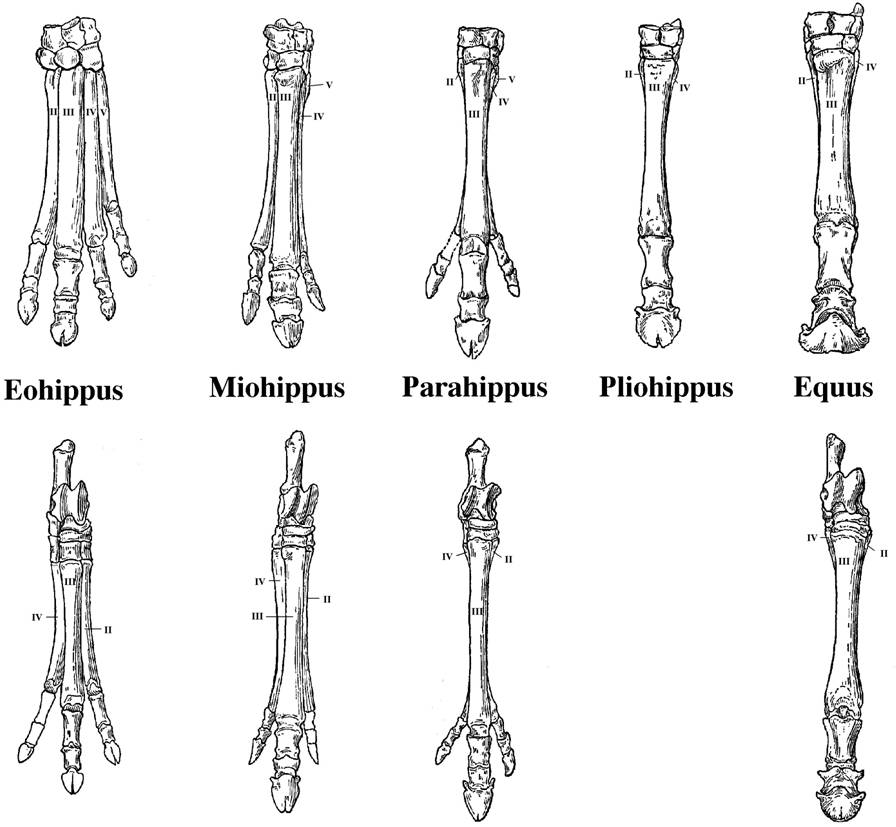
3. Comparative
Anatomy
 a.
Homologous Structures
a.
Homologous Structures
Although having a different outward "look" and although used
for different purposes, they have an underlying similarity in structure - forelimbs
of vertebrates all have one long upper arm bone, two lower arm bones, a bunch
of wrist bones, and five digits. Darwin saw the similarity in structure as important.
An engineer builds different things for different purposes - cars, boats, and
airplanes are structurally DIFFERENT. Here, however, it seemed as if one basic
structure was modified for different uses. Darwin knew why siblings in a family
were similar - they had the same parents (ancestors). He reasoned that these
structural similarities in different species might be due to the same principle
- common ancestry. Also, he observed a correlation: Different uses correlated
with different environments. Could this correlation be causal?
b. Analogous
Structures
Organisms in the same environment often have a similar outward
structure or body plan. For example, flying animals all have an aerodynamic
wing that is wider at the front than at the rear. However, the wings of differnt
animals are differnt in underlying structure. Bats have fingers that support
the membraneous wing, whereas birds lack fingers and the body of the wing consists
of feathers. Insect wings don't involve the limbs at all (even though they have
6!). Again, Darwin observed this correlation with the environment: similar use
(and outward structure) in similar environments. Could this correlation be causal?
c.
Vestigial Organs
These are organs that have no function in one organism (where
they are 'vestigial') but they do function in other organisms. So, some whales
have hip bones, but no legs. Why do they have these bones? Darwin was struck
by the IMPERFECTIONS in nature, as much as the adaptations. Why do men have
nipples? Why do we have muscles that wiggle our ears? Why do we have strong
muscles in the front of our stomach, which are not "load-bearing", and weak
muscles at the base of our abdomen (which rupture in a hernia)? This is a reasonable
relationship in a quadraped, but not in a biped. Why do we have tail bones,
but no external tail? Again, these are NOT well-designed features. In fact,
attributing these imperfect designs to a perfect creator could be interpreted
as heretical. However, when we see them working in OTHER species, it suggests
that maybe we inherited them from common ancestors where they DID serve a function.
As a scientist, Darwin was trying to explain ALL the data (adaptations and imperfections),
he was not simply bringing forward only the data that supported a preferred
position (design).
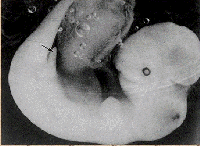 d.
Embryology
d.
Embryology
Embryology reveals homologies and
vestigial structures in both the anatomy of embryos and the process of their
development. For Darwin, the notion that very different vertebrates, such as
fish, amphibians, reptiles, birds, and mammals, would develop from very similar
initial forms was inexplicable from a 'separate creation' perspective. For example,
why do whale embryos (like the one pictured to the right) have hind limb buds?
Why do all vertebrates have folds of tissue in the neck, when only fish develop
them into functional gill slits in the adult? Some anomalies like the recurrent
laryngeal nerves of mammals (described in your book) are explicable in a developmental,
comparative, evolutionary context. Although no modern evolutionary biologist
propounds the notion that an organism "traces their evolutionary history"
as they develop from an egg (this was Haeckel's post-Darwinian idea that "ontogeny
recapitulates phylogeny"), and Haeckel's drawings grossly exaggerated the
similarities among vertebrate embryos, embryos are far more similar to one another
than adults, and embryos are more similar to other embryos than they are to
their own adult form. As we will see when we look at modern contributions from
genetics and developmental biology, the similarities in development are even
more dramatic than anatomy alone suggests.
STUDY
QUESTIONS:
1. Draw
the cell cycle, labeling each stage and highlighting the main event in each
stage.
2. Draw a
chromsome before and after replication.
3. What enzyme
begins the process of DNA replication?
6. Draw a
cell with 4 chromosomes in each stage of mitosis.
7. What
is Platonic essentialism (or 'idealism') and how did it hinder the consideration
of evolutionary ideas?
8. What contribution
did ancient Persians make to the development of the scientific method?
9. What
contributions did Copernicus, Kepler, Galileo, and Newton make to our understanding
of the solar system? Frame these in the context of the scientific method.
10. What
counter-intuitive effect did the renaissance have on the development of modern
(evolutionary) biology?
11. Why
did Buffon criticize the classification system of Linnaeus, which put species
in groups?
12. How
did Lamarck explain the loss of particular fossil species (extinction) through
time?
13. What
is the principle of Natural Theology, as professed by Aquinas and Paley?
14. What observations
did Hutton make, and what did he conclude from these observations?
15. What two patterns
occur in the fossil record that impress Darwin regarding the hypothesis of evolution
and common descent?
16. What are homologous
structures? What correlations occurs with the environment?
17. What are analogous
structures? What correlation occurs with the environment?
18. What
are vestigial structures, and why were they so important to Darwin's refutation
of Paley?
 Living
systems reproduce. In many ways, reproduction seems like the most purposeful
thing that living systems do. Indeed, most nature shows describe this attribute
as a "desire", "goal" or "urge", often described
in these same shows as a process performed "in order to perpetuate the
species". Well, it is currently impossible for us to ascertain the "desires",
"goals" or "urges" of an ameoba or an oak tree; or whether
the amoeba or oak tree is 'thinking' about the survival of its species as it
reproduces. Thankfully, Darwin's theory of natural selection absolves us from
having to understand "desires" - it explains the existence of complex
physiology, morphology, and behavior as a function of the relative benefit of
that trait to relative reproductive success.
Living
systems reproduce. In many ways, reproduction seems like the most purposeful
thing that living systems do. Indeed, most nature shows describe this attribute
as a "desire", "goal" or "urge", often described
in these same shows as a process performed "in order to perpetuate the
species". Well, it is currently impossible for us to ascertain the "desires",
"goals" or "urges" of an ameoba or an oak tree; or whether
the amoeba or oak tree is 'thinking' about the survival of its species as it
reproduces. Thankfully, Darwin's theory of natural selection absolves us from
having to understand "desires" - it explains the existence of complex
physiology, morphology, and behavior as a function of the relative benefit of
that trait to relative reproductive success. A.
The Cell Cycle
A.
The Cell Cycle b.
S
b.
S indirectly causing
the inactivation of cdk-cyclin complexes that would stimulate the onset of the
S phase. Mutations in this gene can make the protein non-functional; so cdk-cyclins
are not inhibited, and the onset of S happens quickly and prematurely - before
DNA repair is completed. This mutation is passed to the daughter cells, too,
along with all the other uncorrected mutations. These mutations accumulate with
each generation of cell division, affecting other genes that influence cell
function and specialization. This unregulated division of undifferentiated cells
creates a cancerous tumour. There are several other 'tumor suppressor' genes,
but mutations in p53 occur in 70% of small cell lung cancers, 80% of non-melanoma
skin cancers, and 60% of colon cancers. Obviously, correct regulation of the
cell cycle is critical to correct cell function and maintaining the integrity
of DNA.
indirectly causing
the inactivation of cdk-cyclin complexes that would stimulate the onset of the
S phase. Mutations in this gene can make the protein non-functional; so cdk-cyclins
are not inhibited, and the onset of S happens quickly and prematurely - before
DNA repair is completed. This mutation is passed to the daughter cells, too,
along with all the other uncorrected mutations. These mutations accumulate with
each generation of cell division, affecting other genes that influence cell
function and specialization. This unregulated division of undifferentiated cells
creates a cancerous tumour. There are several other 'tumor suppressor' genes,
but mutations in p53 occur in 70% of small cell lung cancers, 80% of non-melanoma
skin cancers, and 60% of colon cancers. Obviously, correct regulation of the
cell cycle is critical to correct cell function and maintaining the integrity
of DNA. DNA
replication begins in an unusual way. RNA polymerases, called RNA primases,
create a short strand of RNA on each of the DNA templates, in a 5'-->3' direction.
This occurs because DNA polymerases cannot initiate the process - they can only
add bases to the 3' end of an existing nucleic acid. However, this may also
be a "vestigial" structure of the ancestral RNA world - when RNA polymerases
predated DNA polymerases and may have been used to produce the RNA genomes from
the newly formed DNA template (formed from reverse transcriptase). The short
piece of RNA is know as RNA primer; it provides a free 3'-OH group for the DNA
polymerase to add DNA nucleotides. DNA Polymerases displace the primases and
add DNA to both strands in a 5'--> 3' direction.
DNA
replication begins in an unusual way. RNA polymerases, called RNA primases,
create a short strand of RNA on each of the DNA templates, in a 5'-->3' direction.
This occurs because DNA polymerases cannot initiate the process - they can only
add bases to the 3' end of an existing nucleic acid. However, this may also
be a "vestigial" structure of the ancestral RNA world - when RNA polymerases
predated DNA polymerases and may have been used to produce the RNA genomes from
the newly formed DNA template (formed from reverse transcriptase). The short
piece of RNA is know as RNA primer; it provides a free 3'-OH group for the DNA
polymerase to add DNA nucleotides. DNA Polymerases displace the primases and
add DNA to both strands in a 5'--> 3' direction.  Again,
as the helicase continues to unwind the DNA, the leading strand can be replicated
continuously, just by adding new bases that are complementary to the template.
On the lagging strand, RNA primase must lay down another primer, and DNA polymerase
must 'backfill' the gap, filling in the space "behind" the last RNA
primer sequence. This is accomplished by the DNA forming a loop on the lagging
strand, so it can be pulled through the replisome in the same direction as the
leading strand. DNA polymerase fills in this space with DNA, but it does not
link the DNA to the 5' end of the neighboring RNA primer. So, on this
strand at this fork, DNA synthesis is discontinuous. Short fragments
of DNA are created, beginning with a short primer of RNA. These fragments are
called Okazaki fragments, after the scientist who identified them.
Again,
as the helicase continues to unwind the DNA, the leading strand can be replicated
continuously, just by adding new bases that are complementary to the template.
On the lagging strand, RNA primase must lay down another primer, and DNA polymerase
must 'backfill' the gap, filling in the space "behind" the last RNA
primer sequence. This is accomplished by the DNA forming a loop on the lagging
strand, so it can be pulled through the replisome in the same direction as the
leading strand. DNA polymerase fills in this space with DNA, but it does not
link the DNA to the 5' end of the neighboring RNA primer. So, on this
strand at this fork, DNA synthesis is discontinuous. Short fragments
of DNA are created, beginning with a short primer of RNA. These fragments are
called Okazaki fragments, after the scientist who identified them.  C.
Mitosis
C.
Mitosis 2.
2.
 3.
3.
 3.
3.
 1.
1.
 2.
1543: The publication of two
works had a profound impact.
2.
1543: The publication of two
works had a profound impact.  3.
3.
 4.
4.
 a.
a.
 b.
b.
 c.
Jean Baptiste Pierre Antoine de Monet, Chevalier de
c.
Jean Baptiste Pierre Antoine de Monet, Chevalier de  d.
d.
 A.
Overview:
A.
Overview: a.
a.
 b.
b.
 Paleontology
provided a variety of interesting patterns. First, there were extinct forms
that were different from the species alive today. Although some earlier natural
philosophers suggested that the creatures might still exist in some unexplored
corner of the globe, that was a less satisfying hypothesis in the mid-1800's...
most areas of the globe had been visited by Europeans. Also, the idea of extinction
was repugnant to some people on theological grounds. If God had created a perfect
world, then extinction renders that creation imperfect. Also, if species could
go extinct since the creation, could species also come into existence since
the creation? Just how dynamic was this system?
Paleontology
provided a variety of interesting patterns. First, there were extinct forms
that were different from the species alive today. Although some earlier natural
philosophers suggested that the creatures might still exist in some unexplored
corner of the globe, that was a less satisfying hypothesis in the mid-1800's...
most areas of the globe had been visited by Europeans. Also, the idea of extinction
was repugnant to some people on theological grounds. If God had created a perfect
world, then extinction renders that creation imperfect. Also, if species could
go extinct since the creation, could species also come into existence since
the creation? Just how dynamic was this system?


 a.
Homologous Structures
a.
Homologous Structures

 d.
Embryology
d.
Embryology